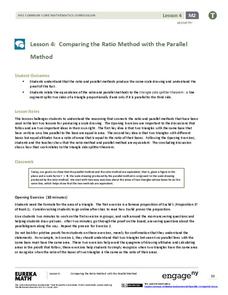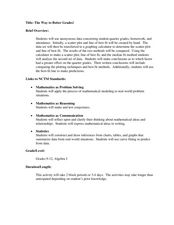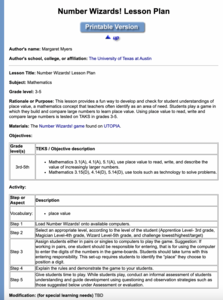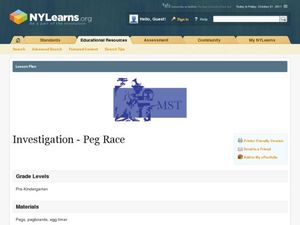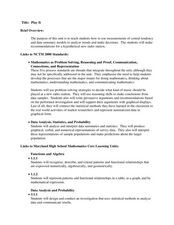EngageNY
Comparing the Ratio Method with the Parallel Method
Can you prove it? Lead your class through the development of the Side Splitter Theorem through proofs. Individuals connect the ratio and parallel method of dilation through an exploration of two proofs. After completing the proofs,...
EngageNY
Multiplying and Dividing Expressions with Radicals
That's radical! Simplifying radicals may not be exciting, but it is an important skill. A math lesson provides explanations of properties used throughout the material. Scholars practice skills needed to multiply and divide...
EngageNY
Definition of Congruence and Some Basic Properties
Build a definition of congruence from an understanding of rigid transformations. The lesson asks pupils to explain congruence through a series of transformations. Properties of congruence emerge as they make comparisons to these...
EngageNY
More Division Stories
Don't part with a resource on partitive division. Continuing along the lines of the previous lesson, pupils create stories for division problems, this time for partitive division problems. Trying out different situations and units allows...
EngageNY
When Can We Reverse a Transformation? 3
When working with matrix multiplication, it all comes back around. The 31st portion of the unit is the third lesson on inverse matrices. The resource reviews the concepts of inverses and how to find them from the previous two lessons....
EngageNY
Experiments with Inscribed Angles
Right angles, acute angles, obtuse angles, central angles, inscribed angles: how many types of angles are there? Learners first investigate definitions of inscribed angles, central angles, and intercepted arcs. The majority of the...
Illustrative Mathematics
Distance across the channel
Here you will find a model of a linear relationship between two quantities, the water depth of a channel and the distance across the channel at water level. The cross section of the channel is the shape of an isosceles trapezoid. The...
Curated OER
Estimate, Solve, and Check
Young scholars estimate, solve, and check a series of addition and subtraction number and word problems. They write their estimates on a recording sheet, compute and write the answer in the next column, and check their answer with a...
Curated OER
Working With Equations
Students create a mathematical formula to help plan ration supplies for a polar expedition. Using basic algebra skills, students identify the variables in planning for rations. They create an equation to help plan the expedition....
Curated OER
The Way to Better Grades!
Pupils collect and analyze data. In this statistics lesson, learners create a scatter plot from their collected data. They use, tables and graphs to analyze the data and mae decisions.
Curated OER
Number Wizards! Lesson Plan
Students play a game in which they build and compare large numbers to learn place value. They use place value to read, write and compare large numbers.
Curated OER
Investigation - Representing Place Value
Third graders demonstrate models to represent a 3 digit counting number. They use manipulative materials to represent place value in whole numbers. Students represent numbers in expanded notation.
Curated OER
Investigation - Distribution
Students match match one notice with one child for all children in their group. They will determine the correct number of notices needed by for the children in their group. Through activities, students discover one-to-one correspondence...
Curated OER
Problem Solving Strategy for Multi-step Math Problems
Third graders analyze mathematical word problems and interpret the words into mathematical equations. Individuals demonstrate their knowledge of the order of operations both verbally and through written expression.
Curated OER
Investigation - The Bakery Shop
Students use manipulatives to establish quantity. By singing a song titled "Five Little Cookies," students determine which strategy to use to find out how many cookies are left in the bakery shop.
Curated OER
Positive and Negative Numbers
Pupils use blocks and markers to illustrate the processes of adding, subtracting, multiplying and dividing integers. In this mathematics lesson plan, learners use Algebra blocks to demonstrate multiplying polynomials.
Curated OER
Investigation - Patterns/Functions
Students will display the first five rows of Pascal's Triangle and discuss in their groups what patterns they see in the rows of numbers. They will give responses and discuss that these numbers form what is called Pascal's Triangle.
Curated OER
Investigation Can You Build This?
Students work in small groups to explore spatial relationships while building with color cubes. Students must identify positions of blocks to partner, recreate a model, and color a sketch of their structure appropriately.
Curated OER
Investigation - Peg Race
Students explore time by comparing the duration of an egg timer with how many pegs they can put in a pegboard. They experience one on one correspondence, as they place a peg in the whole. Students discover estimation of time and number...
Curated OER
Sorting and Classifying
Fifth graders are engaged in sorting and classifying geometric shapes of various colors and sizes. They discuss the properties of these shapes and illustrate a range of classifications using Venn diagrams.
Curated OER
Investigation - What's the Number?: Division
Seventh graders explore number sentences using a variety of strategies making each equation a true sentence. Students examine strategies such as patterns, trial and error, working backwards, and related problems. In groups, 7th graders...
Curated OER
Play It
There are a number of activities here that look at representing data in different ways. One activity, has young data analysts conduct a class survey regarding a new radio station, summarize a data set, and use central tendencies to...
Curated OER
Fact Families - 6, 7, and 42
Students investigate the problems that can be solved only using the numbers 6, 7, and 42. They write the correct number sentences and solve for the solution. Students then give a written explanation for how the problem was solved and the...
Curated OER
Harvest Halloween
First graders brainstorm mathematic manipulatives to assist them with a given set of problems. They work in pairs or small groups and write and/or draw to explain how they solved the problem.
